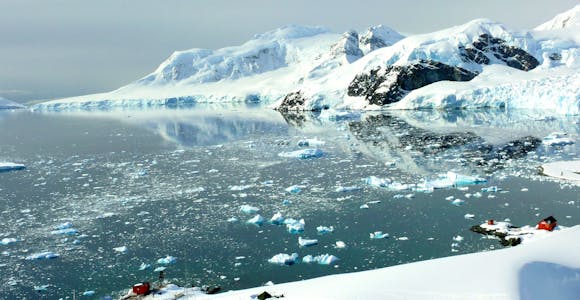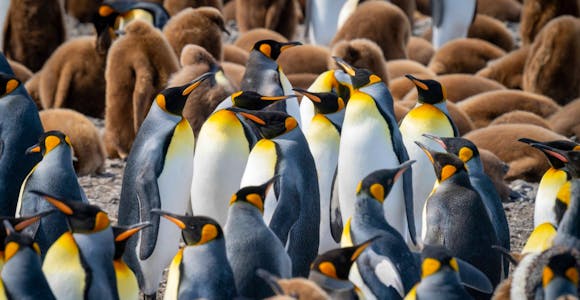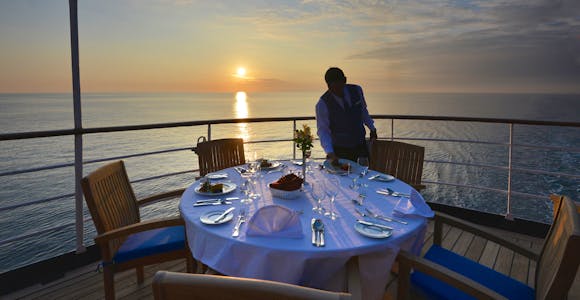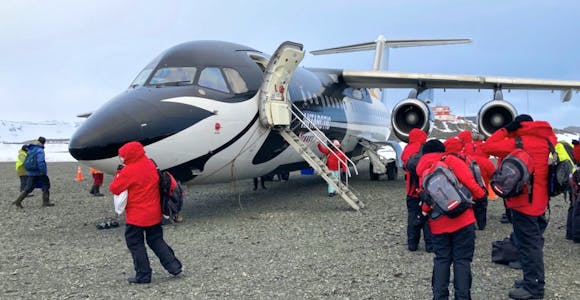
Antarctic Peninsula Cruises
The Peninsula is the classic way to experience Antarctica. Some of the best wildlife and most dramatic scenery can be found in this part of the Frozen Continent.
Discover MorePrice Match Promise - We’ll match any price you find elsewhere for the same trip

Emperor penguins on the pack ice
In the Ross Sea the pack ice dictates the wildlife. Unlike around the Antarctic Peninsula, wildlife encounters must be more actively sought – and feel more earned as a result.
The biggest draw for many visitors is the chance to see emperor penguins. Their colonies are too remote to access but there is a good chance of seeing them in small groups on the ice. In contrast, Adelie penguins abound, with many colonies numbering in the tens or even hundreds of thousands of birds. The only flying birds that breed this far south are South Polar skuas and snow petrels.
Seals gather on the pack ice, including crabeater seals, Weddell seals and the predatory leopard seal. Orcas are often easily spotted here. Many local populations hunt by swamping ice floes with synchronised waves to upend the seals resting on them. Minke and humpback whales are present in the Ross Sea, although with visits being made in January and February sightings are not as common as around the Antarctic Peninsula.

Inside Shackleton's hut at Cape Royds
Ever since James Clark Ross first penetrated its pack ice and gave the Ross Sea its name in 1841, this part of Antarctica has held deep significance to polar adventurers. Scott, Shackleton and Amundsen all set out for the South Pole from its shores, for the simple reason that it was the furthest land south.
Several of their huts have been well-preserved and restored to allow them to still be visited today, becoming places of pilgrimage for modern explorers.
The most famous is at Cape Evans on Ross Island, built for Captain Scott’s Terra Nova expedition and from where he set out to reach the South Pole in 1911 only to perish miles on their return journey. Crossing the threshold here is a deeply emotional experience for many.
Scott’s hut from his earlier Discovery expedition can be found at Hut Point, near the enormous modern US research base McMurdo Station. Also on Ross Island is the hut at Cape Royds, built for Shackleton’s Nimrod expedition from 1907-09.
Finally, Cape Adare is home to the first permanent building in Antarctica and the place where Borchgrevink’s expedition became the first to overwinter on the continent in 1899. It shares its home with the largest Adelie penguin colony in the world.
Travelling to the Ross Sea is the ultimate Antarctic experience. It's hard-to-reach nature means that many people only make it here after visiting the Peninsula and South Georgia. For those that do it's often where they find the true hidden spirit of the White Continent finally revealed.
Cassia Jackson Antarctica Specialist

Volcanic Mount Erebus on Ross Island (Image: T Bickford)
One feature dominates the Ross Sea like no other other: the Ross Ice Shelf. Known simply as ‘the Barrier’ to early explorers, it is a sheet of ice nearly the size of France. Cruising alongside it constantly changing white cliffs and watching great tabular icebergs calve from its edge is an endlessly mesmerising experience.
For many visitors to Antarctica, landing on Ross Island is an ultimate achievement. As well as the possibility of being able to step in the footsteps of Scott and Shackleton, those landing here may gaze in awe at the gently smoking Mount Erebus, or land on beaches layered in black volcanic sand once ejected from its crater and now the site of enormous Adelie penguin colonies.
For the rare ships that visit the Ross Sea equipped with helicopters, there is sometimes the opportunity to make a trip to the McMurdo Dry Valleys in Victoria Land. These snow-free valleys are thought to be the driest places on earth: rain has not fallen here for around 2 million years.

Royal penguins on Macquarie Island
One unexpected highlight of a trip to the Ross Sea is the opportunity to call in en route at the region’s many Subantarctic Islands.
New Zealand’s Auckland, Snares and Campbell Islands, along with Australia’s Macquarie Island are all full of wildlife and unusual fauna, laid out like a string of mini-South Georgias leading you south to Antarctica.
Each island is slightly different, but they offer hiking trails and superb bird watching including the chance to see royal albatross on the nests.
Several species of penguins can be seen here including large king penguin colonies on Macquarie Island along with royal penguins, rockhoppers, erect-crested penguins, yellow-eyed penguins and the endemic Snares penguin: unique among its kind for being able to climb trees.
The waters of these islands are home to thousands of sea lions and fur seals, with southern elephant seals also breeding on Macquarie Island.

Sailing among tabular icebergs on the Ross Sea (Image: Richard Young)
Trips to the Ross Sea operate on a much more restricted schedule than to the Antarctic Peninsula. Because it is located so far south and consequently so much colder, expedition cruise ships are only able to visit during January and February. Beyond this narrow window it is simply not possible to navigate through the sea ice.
There are upsides to visiting in this restricted period. You’ll be there in the height of the Antarctic summer, with near 24-hour daylight, and the extreme cold means a better chance of clear skies.
You’ll also be able to see ice you might not encounter at other times or more northerly latitudes: greasy or frazil ice that forms as the surface of the sea begins to freeze over, very often happening before your very eyes in the wake of your ship. This then turns into beautiful pancake ice, which slowly grows and coalesces into the thick pack that’s the Ross Sea’s dominant feature.
Days at sea fly by with informal lectures from your expert expedition team. You'll learn about the nuances of the changing scenery, the behaviour of the animals, the rich history and all that makes the Ross Sea so special.

MS Adventurer in the Ross Sea (Image: Aaron Russ)
With the Ross Sea on the opposite side of Antarctica to the Peninsula, trips sail from the Port of Bluff on New Zealand’s South Island rather than Ushuaia in Argentina. Christchurch is the nearest international airport.
The logistics of a Ross Sea trip go some way to explaining what makes it such an exclusive destination. As well as having to stick to the narrow January/February visitor’s window, you’ll need to be able to block out a month in your diary to explore it. Voyages here are considerably longer than the average Antarctic Peninsula trip, lasting around 30 days.
It takes six days to sail south from New Zealand to the Ross Sea. A succession of stops to see the wildlife-rich sub-Antarctic islands means that time aboard is frequently broken up, but with regular lectures from the onboard guides, there’s plenty of time to get ready for your destination and meet your fellow explorers.
To visit the Ross Sea, you mainly have a choice of three ships. There’s the comfortable and ice-strengthened MS Adventurer – a real home for the citizens of the sea that all travellers to this region become – and the elegant Le Soleal. With facilities such as a spa and swimming pool, the French vessel lends a sense of luxury to expedition cruising. You can also choose the cutting-edge Douglas Mawson.
Alternative itineraries from other ships are occasionally available, offering an exciting semi-circumnavigation of Antarctica as they move between Argentina and New Zealand.
Visiting the hut from where Captain Scott left on his fateful expedition to the South Pole is almost like visiting a chapel. Full of emotion, you can’t help but talk in whispers, half expecting his men to walk in at any moment and brush the snow from their boots.
Tennessee Historian & Polar Guide
Ross Sea Cruises trips scored 3.6/5 from 9 reviews
The fact that the Ross Sea is only safely accessible in January and February puts a tight restriction on the number of vessels that can operate there: most polar ship operators understandably choose to concentrate on the longer season around the Antarctic Peninsula.
Some ships occasionally operate an itinerary that relocates from the Peninsula to the Ross Sea – an epic two week voyage in itself, cruising along Western Antarctica through the Bellinghausen and Amundsen Seas, but these are the rare special exception rather than the norm.
These voyages typically start from around $29,000 USD per person (£23,000 GBP), depending on cabin category, although offers are sometimes available.
Compared to shorter cruises from the toe of South America to the Antarctic Peninsula, these Ross Sea voyages appear at first glance considerably more expensive. However, you'll want to bear in mind that any voyage to the Ross Sea is considerably longer than one to the Peninsula due to the greater distances to be covered. The logistics are much more complicated, operating in one of the world's genuinely most remote regions. The boats tend to be smaller with fewer passengers and the operating costs are generally higher, particularly if the ship is required to push through ice.
With so few departures each year and so much interest, these voyages can easily book up more than two years in advance. Wait lists are common so you need to plan well ahead and prepare to be patient. Visiting the Ross Sea is always an expedition in its truest sense, but the wait is more than worth it worth it!
Even experienced visitors to the Antarctic Peninsula comment on how much colder it is in the Ross Sea. Temperatures below -30C/-22F during a visit are not unknown. Before you travel you’ll be given detailed packing advice, and during the trip the guiding team will give extra pointers on the best way to get dressed and keep warm during the trip, especially during zodiac cruises when you are most exposed to the elements. The Ross Sea is an extreme environment but the rewards are more than worth it.
As on any Antarctica trip, wildlife sightings are never guaranteed. However, there is normally a good chance of seeing emperor penguins on a Ross Sea cruise. Their colonies here are too remote to access, so instead you’ll be watching out for small groups and individuals on the pack ice.
The expedition team will make every effort to land at the historic huts of Scott and Shackleton of Ross Island, but visits can never be guaranteed. Everything in the Ross Sea depends entirely on the sea ice, whose extent changes from year to year and day to day.
As a rule, the huts on Ross Island have generally proved more reliable to access, though this always remains hard to predict until the voyage is underway. Borchgrevink’s hut at Cape Adare is notoriously difficult to land at due to its exposed location, as big ice here often makes safe navigation difficult.
McMurdo Station is the size of a small town, with up to 1200 scientists and support personnel living there during the Antarctic summer, a short distance from Scott’s Discovery hut on the southern tip of Ross Island. It has its own bowling alley, annual music festival (Icestock) and the world’s most southerly ATM.
Before Covid-19, the base sometimes welcomed groups of cruise ship passengers to give tours of part of the station. Under current protocols, this practice has ended and it is not known if or when visits will be allowed again.

The Peninsula is the classic way to experience Antarctica. Some of the best wildlife and most dramatic scenery can be found in this part of the Frozen Continent.
Discover More
A jewel in Antarctica's crown, South Georgia is one of the world's great wildlife destinations: the Serengeti of the Southern Ocean
Discover More
From the onboard service and comfort of the suites to their fantastic expedition teams, luxury Antarctica cruise ships deliver a truly first-class polar experience.
Discover More
Fly & Cruise trips offer the best of Antarctica in one simple package: flying to the Peninsula in two hours to join an expedition cruise ship for a classic polar adventure.
Discover MoreWe'll spend some time listening to your aspirations, then discuss the kind of experience that might suit you.
Next we'll discuss the options, shortlist the best trips for you and present you our impartial recommendations.
We'll place a 24 hour hold on your preferred option - without obligation - whilst we talk through the details.


